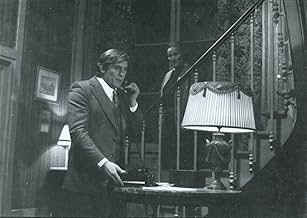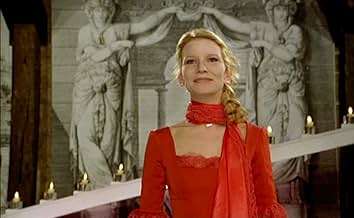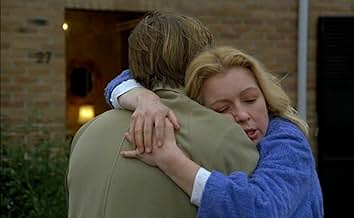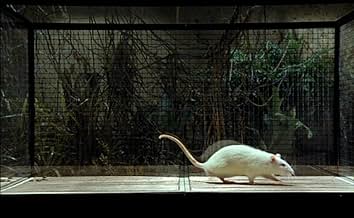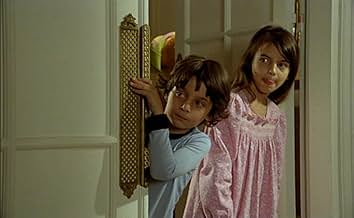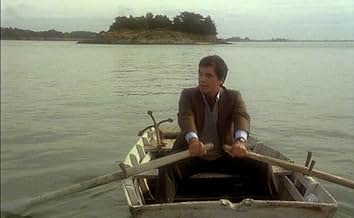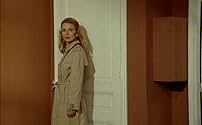CALIFICACIÓN DE IMDb
7.6/10
7.2 k
TU CALIFICACIÓN
Un hombre de negocios, un escritor y una aspirante a actriz son utilizados como ejemplos por el profesor Henri Laborit para ilustrar sus teorías sobre el comportamiento.Un hombre de negocios, un escritor y una aspirante a actriz son utilizados como ejemplos por el profesor Henri Laborit para ilustrar sus teorías sobre el comportamiento.Un hombre de negocios, un escritor y una aspirante a actriz son utilizados como ejemplos por el profesor Henri Laborit para ilustrar sus teorías sobre el comportamiento.
- Dirección
- Guionistas
- Elenco
- Nominado a 1 premio Óscar
- 11 premios ganados y 12 nominaciones en total
Maurice Gautier
- Le père de René
- (as Maurice Gauthier)
- Dirección
- Guionistas
- Todo el elenco y el equipo
- Producción, taquilla y más en IMDbPro
Opiniones destacadas
What an odd way to start a film. We seem to be hearing a lecture about the brain, and human development, interspersed with introductions of several characters who don't seem to have much in common. But then Resnais starts working his magic, intertwining the stories of three people with the behavioral theories of Henri Laborit. Human behavior is compared to the behavior of lab rats, and even turtles and wild boars, and each new idea is illustrated in the lives of the main characters. And as an interesting third layer, each character has an "avatar" from classic French cinema; clips from their films are interspersed to comment on the action.
Too bizarre, you think? I thought so at first, but after awhile I was hooked. Fine performances, beautiful cinematography, and a captivating, multi-layered script makes this film an unforgettable experience.
Too bizarre, you think? I thought so at first, but after awhile I was hooked. Fine performances, beautiful cinematography, and a captivating, multi-layered script makes this film an unforgettable experience.
I've seen this film twice. The first time, it told me how to view the world. The second time, it represented my view of the world. Everyone's actions are determined by a small number of forces, it says. Everyone's behavior fits into only four categories, it says. And yet, it presents such a wide range of emotions, actions, and thoughts that it seems to contradict its very hypothesis. And yet, it doesn't. Turn your brain on and watch this; give it time to sink in, then watch it again. I guarantee it will change your way of looking at the world. The editing is top-notch, and Resnais is at the top of his form, as he was 20 years earlier with Hiroshima Mon Amour. The ending is a stunner, and it encapsulates the film while at the same time extending its meaning. The cinematography and message will remind you of Resnais' Night and Fog. Brilliant performances from all three leads and Laborit. Give it time, use your brain, and view it multiple times. You will be rewarded.
Yes, as my summary went, Mon Oncle d'Amerique did for me, what the clever but emotionally vacant "Adaption" did not(could not). It impaled me.
I have always had a bad taste in my mouth with that Jonze/ Kaufman offering, because it was too smug for its own good and worse, it was emotionally condescending.
But here comes a classic that thumped its nose at conventional human drama and yet came out becoming more humane than most films I have ever seen. Who knew Biological Psychology/ Behavioural Science could breathe such life and heart into a seemingly inconsequential story?
Anyone know where to find a transcript of the film? The last lines uttered by the Doctor summed up everything I loved about this film(and I have seen it just this once!!).
Excellent.
Again, many thanks to my enlightened film buff friends I have met on the net for their strong recommendation of this exceptional master work. For my experiential education in film has received that giant leap with this film.
Will definitely revisit this thought provoking film to fully soak in its wisdom and movie magic. One of the best films I have seen this year!! If you can get hold of it, by all means take that leap, much like I did and be immeasurably rewarded.
I have always had a bad taste in my mouth with that Jonze/ Kaufman offering, because it was too smug for its own good and worse, it was emotionally condescending.
But here comes a classic that thumped its nose at conventional human drama and yet came out becoming more humane than most films I have ever seen. Who knew Biological Psychology/ Behavioural Science could breathe such life and heart into a seemingly inconsequential story?
Anyone know where to find a transcript of the film? The last lines uttered by the Doctor summed up everything I loved about this film(and I have seen it just this once!!).
Excellent.
Again, many thanks to my enlightened film buff friends I have met on the net for their strong recommendation of this exceptional master work. For my experiential education in film has received that giant leap with this film.
Will definitely revisit this thought provoking film to fully soak in its wisdom and movie magic. One of the best films I have seen this year!! If you can get hold of it, by all means take that leap, much like I did and be immeasurably rewarded.
Usually with films we supply our own model of viewing, what values and parameters we accept to matter. Here the model is built in the film itself. It's an epistemological vision of human behavior patterns, guided by a behavioral biologist. We are provided with a set of criteria that govern our actions, fight or flight, actions taken to prolong pleasurable sensations or to avoid their opposite, and based upon the scientist's research, Resnais creates scenarios to exemplify them. Theory in practice, more or less.
This is the first handicup of the film for me. Resnais's consistent mark of genius has been his ability to visualize the mind as a threedimensional space, where by characters who act as our proxies into this world of the mind we can wander that space in an effort to discern the mechanisms that sustain it. How the forms we later experience as real come into being, illusionary. His vision is poignant for me precisely because it is translated as cinema, which as a blank canvas where upon it various flickering narratives are projected, is an ideal replica of the mind. He gave us Hiroshima and Marienbad, which is more than most directors contributed to the medium.
But Resnais always approached his subject as a poet, with capacity for awe and mystery, whereas now his vision feels constricted to fit criteria and structures.
Nonetheless the film does well to present us with situations we may know from life. An illicit thryst, frustrations at work, various ambitions for love or power thwarted, the outcomes of these don't matter. We're meant to identify the roots of suffering, how it arises in the form of sensation within the matrix that we experience as reality.
So far the film is wise, in showing us to be lab rats trapped in a glass panel box which is intermittently electrocuted by unseen devices. Perhaps we come to understand by this how suffering is an inate response to life in the cage, therefore inescapable. And how the devices that produce our suffering are invisible to us from inside the cage. Even more importantly, how our various attempts to imprint meaning on the objects of our world, by naming them or pretending to arrange them into patterns or hierarchies, are merely masks we have devised to conceal simple impulses and desires. To be safe or sated, or to avoid pain.
But the film is cautiously scientific, and will not venture further. The above important realization is mute for me without the spiritual. It is a dry understanding of fascinating stuff.
None of which is very subtle anyway. We're lectured a bit. We actually revisit excerpts of earlier scenes so we can identify specific reactions as narrated to us by the scientist. The lab rat metaphor couldn't beat us around the head more, if we actually saw the actors with the head of a rat reenact an angry exit. Wait, we do! But none of this bothers me overmuch. What bothers me is the pessimism.
Which is to say that having understood all this, the mechanisms that control the apparent reality we experience as our everyday routine, we are in position to transcend them. Our bodies may remain in the cage, yet having understood all this, how various forms of ego and desire blind us, our consciousness is already out of it. A glimpse out of the box is possible. Or as the film says, understanding the laws of gravity does not mean we escape them but we can get to the moon.
This is of course a fundamental attribute of how we are not like animals. We are not even animals with the unique ability to remember and form connections between the objects of memory. We are spirited beings. The film, conservative as issued under the credence or pretence of science, does not dare to articulate as much.
But then we have the final image, which says more than most films ever did. It's something I'll want to keep inside of me.
We see the mural of a tree painted on the brick wall of a building. From a distance, it looks beautiful, perhaps the real thing. But once up close, we see the beautiful, harmonious shape for what it is. Bricks as particles, a structure ugly, functional, nondescript, bearing no resemblance to the overall shape.
Two levels of reality then, apparent and ultimate. Order, shape, meaning from afar. Distinctions between brick and tree, as created in the eye. But once inside we understand the emptiness, the sameness of everything. How the above attributes are illusionary, imprints of the eye upon the wall. Will this image terrify or soothe you?
Perhaps the film understands more than it lets out from its cautious application of science. This is one of the 5 best metaphors in the history of cinema. It's so good, it's worthy of being in Blowup.
This is the first handicup of the film for me. Resnais's consistent mark of genius has been his ability to visualize the mind as a threedimensional space, where by characters who act as our proxies into this world of the mind we can wander that space in an effort to discern the mechanisms that sustain it. How the forms we later experience as real come into being, illusionary. His vision is poignant for me precisely because it is translated as cinema, which as a blank canvas where upon it various flickering narratives are projected, is an ideal replica of the mind. He gave us Hiroshima and Marienbad, which is more than most directors contributed to the medium.
But Resnais always approached his subject as a poet, with capacity for awe and mystery, whereas now his vision feels constricted to fit criteria and structures.
Nonetheless the film does well to present us with situations we may know from life. An illicit thryst, frustrations at work, various ambitions for love or power thwarted, the outcomes of these don't matter. We're meant to identify the roots of suffering, how it arises in the form of sensation within the matrix that we experience as reality.
So far the film is wise, in showing us to be lab rats trapped in a glass panel box which is intermittently electrocuted by unseen devices. Perhaps we come to understand by this how suffering is an inate response to life in the cage, therefore inescapable. And how the devices that produce our suffering are invisible to us from inside the cage. Even more importantly, how our various attempts to imprint meaning on the objects of our world, by naming them or pretending to arrange them into patterns or hierarchies, are merely masks we have devised to conceal simple impulses and desires. To be safe or sated, or to avoid pain.
But the film is cautiously scientific, and will not venture further. The above important realization is mute for me without the spiritual. It is a dry understanding of fascinating stuff.
None of which is very subtle anyway. We're lectured a bit. We actually revisit excerpts of earlier scenes so we can identify specific reactions as narrated to us by the scientist. The lab rat metaphor couldn't beat us around the head more, if we actually saw the actors with the head of a rat reenact an angry exit. Wait, we do! But none of this bothers me overmuch. What bothers me is the pessimism.
Which is to say that having understood all this, the mechanisms that control the apparent reality we experience as our everyday routine, we are in position to transcend them. Our bodies may remain in the cage, yet having understood all this, how various forms of ego and desire blind us, our consciousness is already out of it. A glimpse out of the box is possible. Or as the film says, understanding the laws of gravity does not mean we escape them but we can get to the moon.
This is of course a fundamental attribute of how we are not like animals. We are not even animals with the unique ability to remember and form connections between the objects of memory. We are spirited beings. The film, conservative as issued under the credence or pretence of science, does not dare to articulate as much.
But then we have the final image, which says more than most films ever did. It's something I'll want to keep inside of me.
We see the mural of a tree painted on the brick wall of a building. From a distance, it looks beautiful, perhaps the real thing. But once up close, we see the beautiful, harmonious shape for what it is. Bricks as particles, a structure ugly, functional, nondescript, bearing no resemblance to the overall shape.
Two levels of reality then, apparent and ultimate. Order, shape, meaning from afar. Distinctions between brick and tree, as created in the eye. But once inside we understand the emptiness, the sameness of everything. How the above attributes are illusionary, imprints of the eye upon the wall. Will this image terrify or soothe you?
Perhaps the film understands more than it lets out from its cautious application of science. This is one of the 5 best metaphors in the history of cinema. It's so good, it's worthy of being in Blowup.
10solace-3
This film was made with the cooperation of psychologist Henri Laborit. It's broken down, like a greek drama, into narrative episodes and odes where the chorus, in this case psychologist Laborit, explains the meaning of the episodes. I love this movie because it makes clear the pretenance to everyday life of a discourse which is very rich as an interpretation of life, in exactly Matthew Arnold's sense, but at the same time so abstract that most people just, for example, reading Laborit's "Decoding the human message" would not see the immediate relevance of what was being said to their own daily concerns. I use this film to teach psychology. I open my intro class with it every term. Learning to read this film is learning to think like a psychologist. In the film, we cut from scenes of the human characters involved in various relationships to Laborit showing how lab rats react to stress under various conditions. The result is not dry or pedantic but funny as hell. It comes off as the rats doing a low burlesque of the human comedy. We also see the characters as children and as adults and scenes from various formative episodes along the way. When Laborit says "a person is a memory which acts" it seems a powerful commentary on what we are seeing on screen. We see one character as a tiny girl interacting with her factory worker father. He is a communist and he is teaching his newly articualte baby girl to repeat after him "USA go home". Watching this, I remember being taught to sing "Jeusus loves me" shortly after I started talking. This film is funny and wonderful dealing with the thing which matters most of all, the question of what it means to be a person.
¿Sabías que…?
- TriviaThere are several scenes from films featuring Danielle Darrieux, Jean Marais and Jean Gabin used in this film.
- Citas
Henri Laborit: [First lines] A being's only reason for being is being. In other words, to maintain its organic structure. It must stay alive. Otherwise, there is no being.
- ConexionesEdited from La belle équipe (1936)
Selecciones populares
Inicia sesión para calificar y agrega a la lista de videos para obtener recomendaciones personalizadas
- How long is My American Uncle?Con tecnología de Alexa
Detalles
Taquilla
- Total a nivel mundial
- USD 38,465
- Tiempo de ejecución2 horas 5 minutos
- Mezcla de sonido
- Relación de aspecto
- 1.66 : 1
Contribuir a esta página
Sugiere una edición o agrega el contenido que falta

Principales brechas de datos
By what name was Mi tío de América (1980) officially released in India in English?
Responda
![Ver Bande-annonce [OV]](https://m.media-amazon.com/images/M/MV5BYWEzZjZmODAtMjgzNS00NTYzLTgyZDctZTFhYWE4OTE3NTFkXkEyXkFqcGdeQXRyYW5zY29kZS13b3JrZmxvdw@@._V1_QL75_UX500_CR0)
